#hyperfin
Explore tagged Tumblr posts
Text



Hyperfin

#hot wheels#hotwheels#diecast#smash or pass#polls#2020#hyperfin#fast and furious#more cars with retractable wings#sorp
3 notes
·
View notes
Text
we were recently talking about this with my friends so now I'm curious:
*on Earth's surface. Airplanes and the like don't count. There's no option for astronauts either. The lunar ones did touch ground tho, so if you happen to be one, you can honorarily tick yourself under the top elevation bracket.
The delimiter numbers do appear twice, so if you happened to have been to the elevation of e.g. exactly 800 m, down to the last tick of the hyperfine transition frequency of the Caesium-133 atom, you can count yourself in the higher elevation bracket. (The effect of rounding in the conversion between meters and feet will have produced more of a difference anyway. Sorry, wikifeet supporters ¯\_(ツ)_/¯)
And yes, the first option is indeed mainly intended for the Dutch if you were wondering.
213 notes
·
View notes
Text
space probes and football
I read 17776 about a week ago and besides being totally blown away and in love with the concept, it also got me thinking. Now I, being a fanfic lover (as many on this hellsite are), ran to ao3 for fan content as soon as I could. And, of course, I ran to Tumblr as well. And then I maybe fell down a wormhole.
Those who are familiar with the story will know that JUICE mentions this plaque on Pioneer Ten with naked people on it. We don't get a ton of context for that, so I obviously Wikipedia'ed it because what else was I supposed to do? Just accept the fact that a space probe had naked people on it and move on? I think not.
Here's a photo of the plaque, for reference:

So, to quickly break down everything on there, it's clearly a man and a woman in the nude, and then we have the hyperfine transition of hydrogen in the top left (don't ask me what that is; I have NO CLUE), a radial pattern to show the distance of pulsars to the sun and center of the galaxy?, and then, of course, the solar system at the bottom and a silhouette of the spacecraft at scale behind the people.
All this detail was reserved for two plaques: one on the Pioneer Ten and one on Pioneer Eleven, from 1972 and 1973 subsequently. At this point we've lost contact with both probes, whose purposes were pretty much to observe space and the solar system. The inclusion of the plaques was purely to provide some sort of information on the Earth if the probes were at any point encountered by intelligent alien life.
Next I want to turn my attention to the Voyager Golden Record, two identical records made for about the same purpose as the plaques that were launched on their crafts in 1977. What's interesting is that we still have contact with the Voyager probes, whose original missions were to explore far reaches of the solar system but have since moved far beyond the Sun and into interstellar space and are reporting on that.
Now, the records carried on Voyagers 1 and 2 contain sounds and images of the Earth, including over a hundred photos and sounds of human life, greetings, and music. The records also have many engravings similar to that of the plaques on them.

17776 posits that we live in a universe with no other intelligent life, and that people are perfectly okay with that. But all evidence of these "time capsules" says otherwise. All evidence says that people are always looking to space for more -- for answers that space may not be able to give.
I think that if we really were alone on this planet, it would be terrifying. Again, 17776 poses the idea that humans inherently seek out play above all other change. But isn't exploration play in itself? Isn't play just another form of discovery? And if it is, isn't space exploration and discovery inherently human?
I think people have by far accepted that there is a nonzero chance of aliens existing. And in a universe that is, for all intents and purposes, infinitely expanding, a nonzero chance is practically a confirmation, isn't it? Even in a universe as insanely empty as 17776's, I can't imagine humanity giving up on that small chance that we're not alone out here.
The idea that we're not unique in our existence is strongly non-creationist, which I will admit freely. It belies the fact that we are not a chosen people after all. But I think that we have a built-in desire to not want to be alone in the big, dark universe. Not a pale blue dot within infinite vastness, but rather part of a larger group.
Voyager 1 is the most distant human-made object in space ever. I think that's incredible. Maybe one day, extraterrestrial life will stumble upon our probes and play our records and hear the whale sounds recorded on them. Maybe they won't. But all signs show that we want them to.
#17776#17776 football#voyager 1#voyager 2#pioneer 9#pioneer 10#pioneer 11#anyways#that's just me rambling about nothing#i'm not even trying to make a big point#i just wanted to talk about space#and voyager#and pioneer#and i want to learn more#today i learned#til#okay#enough tags
15 notes
·
View notes
Note
since the poll is over, can we know your height now?
sure, at this point it does not spoil the fun.
you know how the SI unit of time, the second, is defined in terms of the period of the transition between the two hyperfine levels of the ground state of caesium-133? my height is roughly the distance light travels in fifty-one and a half of those periods.
35 notes
·
View notes
Text
Thus, spin-exchange collisions between alkali metal atoms can change the hyperfine state of the atoms while preserving total angular momentum of the colliding pair.
"Hyperfine" is a song by Australian indie pop singer G Flip. It was released on 8 May 2020.[1]
physics is fascinating
19 notes
·
View notes
Text
(the 2 most voted elements will continue onto round 2!)
More info about each element (and propaganda for the ones I like) under the cut. pleeeeeeeeease read some of them at least the one about francium
(disclaimer: these are based off short wikipedia reads and my crumbling high school chemistry knowledge. correct me if I'm wrong about anything.)
HYDROGEN: Hydrogen is the lightest element (consisting of only one proton and one electron). It is also the most abundant element in the universe, it's a gas (at room temperature) and it can explode. It's also quite representative of acids, having the (Arrhenius) definition of an acid straight up saying that it has to dissociate in water to form H+ ions. It's also quite an efficient fuel. Hydrogen is anywhere and Hydrogen is everywhere. If you like explosions, sour beverages, or acid in general, consider voting Hydrogen!
LITHIUM: Lithium, under standard conditions, is by far the least dense metal and the least dense solid element! You may primarily know him from your phone's Lithium-ion batteries. There are Lithium-based drugs used to treat mental illnesses. You can throw a block of lithium in water and it will make a really big explosion. The metal is soft and silvery. I'm running out of things to say about him. If you like batteries vote Lithium? (edit: just realised lithium is used for batteries, and batteries are connected to robotics and engineering. if you like robots and cool mechanical stuff vote lithium!)
SODIUM: You must know him from table salt. That's actually NaCl, his best known involvement. There are many more very important and very commonplace compounds that involve sodium, such as baking soda (NaHCO3) and sodium hydroxide (NaOH) (that's probably the most famous base?). It's also very important to the human body (you shouldn't eat more than 2300mg a day). If you've ever used table salt or baking soda while cooking, consider voting Sodium!
POTASSIUM: Their name was based on the word potash, which was based on an early and easy way of obtaining potassium, from putting ash in a pot, adding water, heating, and evaporating the solution. It's used in a lot of fertilisers because it's an essential plant nutrient. It's also involved in a ton of important compounds: KOH (a strong base), KNO3 (often used as salt bridges in electrochemical cells), K2CrO7 (an oxidising agent often used in organic synthesis), and K2CrO4 (I don't know what this one does). If you have ever eaten food from fertilisers consider voting Potassium!
RUBIDIUM: Rubidium compounds are sometimes used in fireworks to give them a purple color. They've also got a cool name, based on the latin rubidius, for deep red (the color of its emission spectrum). I'll be real, I don't really know much about them beyond that, but that is one cool name. Vote for Rubidium if you like cool names.
CAESIUM: Caesium is used in the definition for a second, meaning that an entire SI unit is based on it! A second can be defined as "the duration of 9,192,631,770 cycles of microwave light absorbed or emitted by the hyperfine transition of caesium-133 atoms in their ground state undisturbed by external fields". It was also discovered from mineral water. Did you know that they had to use 44000 liters of water to find her? If you've ever experienced time or had a conception of it in terms of units, consider voting Caesium!!!
FRANCIUM!!!: Caesium... TWO! It's sad that no one will probably read this far but this is my favourite element in this poll. This element is characterised by instability. Her longest half-life is 22 minutes. Her entire existence was conjoint with Caesium before they discovered that she was her own element. She has never been seen. They literally never confirmed what color she is. She was born in a wet cardboard box all alone. Through the hands of different scientists, she was going to be named after Russia, Virginia, or Moldavia at different points in time. At one point the name catium was proposed (for "cation", since she was believed to be the most electropositive cation), but was rejected because it sounded like a cat element. Which is so fucking sad. We could've had cat element but we ended up with France element. That's right she's also named after France. Just tragic fascinating existence overall. Also isn't it just insane that her half-life is only 22 minutes? Dude, you don't get it, the most of her that's ever existed in one place is a mere 300000 atoms. She's here and she's gone. What the hell.
The charm of Francium can be summarised by the wise words of my good friend Wolfgang Amadeus Mozart:

20 notes
·
View notes
Text
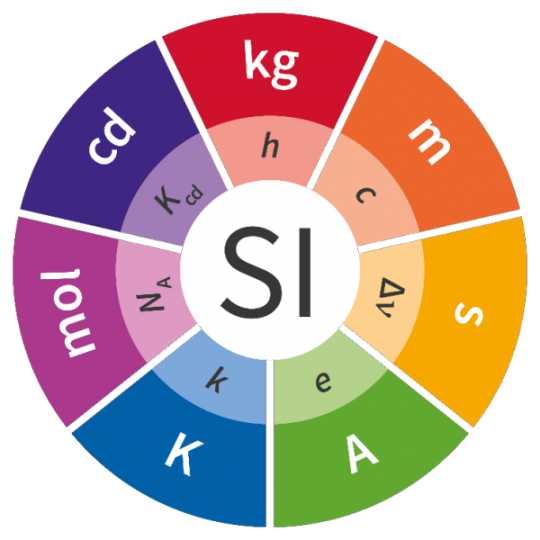
International System of Units
The international system of units, typically abbreviated as SI Units (for the French Système International) is a globally agreed upon system of units of measurement. As of 2019, there are seven base units, defined with the values of seven constants that describe the natural world.
The base unit of time is seconds, the base unit of length is the meter, the base unit of mass is the kilogram, the base unit of electric current is the ampere, the base unit of temperature is the kelvin, the base unit of the amount of a substance is the mol, and the base unit of luminous intensity is the candela. Other quantities and units in the SI system are derived from these seven units.
The seven constants are the "unperturbed ground state hyperfine transition frequency of the caesium-133 atom", the speed of light, the Planck constant, the elementary charge, the Boltzmann constant, Avogadro's constant, and the "luminous efficacy of monochromatic radiation of frequency 540 x 10^12 Hz".
Sources/Further reading: (Official Governing Body) (Wikipedia) (Image source)
23 notes
·
View notes
Text
hi this is just my very long brainrot + highlights + quotes i cannot get over after watching the most recent fernando interview (rambles below the cut, read at your own discretion)
When I say high performance what do you think of? “Delivering higher than expectations and having that extra something on everything you do.”
It’s unlimited for him. He’s been in this mindset for all his life and he probably won’t stop functioning at this level of “pure motivation”. It’s a way of life
His quiet amusement when they bring up him starting karting at THREE years old
“And I think the race was 15 laps and I did two of them. But they told me that I won the race so I was happy after all and yeah, that’s how it started.”
Humble origins? “I don’t know how I can be that competitive in everything I do because my family in general are not at all competitive.”
Fernando knew how to hold a grudge (!) “I could maybe not talk to them for one full day if I was not winning [at cards]” etc.
The moment when it really clicked that he HAD to win was as a defending champion (coming back to the Spanish championship in ‘97 after winning the Karting WC in ‘96)
“When I have this pressure I try to calm myself”
He deals with the expectations by knowing everything about what he’s going into.
EVERYTHING.
Asks about strategy like 5 times, prepares every contingency plan etc.
This applies to his daily life and I quote “When I’m at home relaxing [...] or there is a tennis match or whatever, I treat that tennis match like a Formula One Grand Prix. So I have to know everything about with who I will play with.” Literally all about the hyperfine control.
“If he’s too strong maybe I skip that day at the tennis because I hate losing.” I love him so much.
What is your relationship like with self-doubt? shrugs, smirks “Not much.” THE CHARISMA oh god.,,,?????
ALSO, FERNANDO ALONSOS THINKING FACE (see this excellent post)
also also this seems a good place to add his like totally random head scratches and fidgets and most adorable face scrunches. such a cutie patootie energy ball.
This man avoids self-doubt by just TOTALLY avoiding the things he’s bad at?????
“I’m doing what I know that I can do and on that specific thing, I don’t have much self-doubt or I don’t have many problems.”
He never thought he was slower than Michael Schumacher
“a kamikaze approach to Formula One and to the start of my career”
He loves Dakar so much and it’s so evident hehehee. He can find fulfilment here I think, being “two weeks in the middle of nothing on a tent”.
How does comparison work for you then? “I don’t know.”
He wants to spend more time with his family (!!) It’s a life he “wants to live in the next 40 or 50 years”.
Media attention/paparazzi? He’s more bothered by it than his parents and he really really values his privacy
On his first race in F1 in 2005, he called his father and his father said “Try to enjoy because maybe it’s your last race.” His family is just so content with anything that could happen, even the possibility of quote-unquote failure. Everything is just a gift.
He views F1 as more “selfish, more glamorous but also fake in another way”. F1 circus.
“I’m taking care a bit more of fans and TV and these kind of things because I understand the importance of it.” aka justifying your TikTok addiction,,,....???
I didn’t take one moment to enjoy my career because I was too focused on winning? without hesitation “Same!!!” (I regret that, I regret that)
“Celebrating every weekend is part of my thing now” It’s good imo that he took a step back and learnt to enjoy more his little successes :”))
Did I mention he’s so so detail-oriented?
“executing the race as a robot” so many fic ideas here lol “no emotion. And just there is only one way to see the chequered flag faster than any other possibility.”
“That’s the beauty of the sport, that even if you want to do something with no emotion, everything comes alive in certain moments of the race.”
He knows his stats :0
He says “bwoah” or “mwoah” a surprising number of times for someone who is not Kimi
His life is basically built around confidence and discipline and this also translates to how he deals with disappointment and pain
Sometimes he can’t digest losing the races/not podiuming for a few hours or until the next morning
There is always a plan and once that’s drilled into you it’s very easy to keep going
80% plans that he expects to go perfectly and 20% contingency plans because “you don’t want to spend too much time in the suboptimum”
If he could go back in time he would want to win a championship with Ferrari (don’t we all)
“There is a new life, you know, in a few years’ time for me without driving.” Retirement????? A F E W YEARS????????
“I should have enjoyed more and [...] I would just change to live a little bit more, all those moments, and try to have more memories from those moments. I won the championship in Brazil 2005/6 and I hardly remember anything from those afternoons and nights, which is sad…” Oh Fernando…
“I would love to win the championship again, but it’s not the highest priority.”
“Winning Dakar one day is a high priority for me as well.” HE REALLY LOVES DAKAR AND HES SO CUTE ABOUT IT UGHHH “IF I WIN IN DAKAR THAT WILL FEEL FOR ME SOMETHING SPECIAL AS A DRIVER AND AS A PERSON”????? SO so so cute
He loves people who are confident. He’s attracted to people who are “so sure of what they’re doing”. He finds them powerful.
“College is beautiful time”
What is the hidden cost of your achievements? “Nothing really.”
“Probably not being in the sport and not being an F1 driver I probably would have my own family by now, but that’s something that you never know.” ???????? wdym you never know but YES nando loves kids good to know
How happy are you? (they dropped that like a bomb) the answer is “9, 9.5 [out of 10]”.
THE HEAD OF MECHANICS IN HIS GOKART TEAM SAID “THERE IS NOT MUCH TO CELEBRATE” WHEN HE GOT SECOND IN THE WORLD CHAMPIONSHIP
HE WAS T H I R T E E N let a guy be happy cmon
“you win or you don’t” That actually maybe explains how Nando used to be when he was younger
One piece of advice for listeners? “Self-confidence. Being prepared for everything you do in life. You cannot be happy with anything. You have to always search for something better.”
How much did you prep for this interview? “Not much, I was in the sim this morning.”
link
thanks for reading my absurdly long brain vomit !! lmk what yall thought of this :)
17 notes
·
View notes
Note
Hi! I wanna ask what inspired you to write A scholar's dream🥺
(that picture is irrelevant just wanna share a cute hunter-kitty with youXD )

Hi Odds! Thank you for the cute meme!
Ah well it's quite an interesting story! You see one of my first Bloodborne drawing and story I create in my head was the knight and beast story. (back in may 2022 even if I wrote the story way later). This lil one shot was my first try to write a fic and it help me test the water and see I was capable of writing.
Then I start to try picture and create in my head (because I love doing those) what the story and lore of some characters was like. And that isn't told within the game.
How the characters (Laurence, Maria, Gehrman, Ludwig etc) ended where they end up. How they meet, what happened in their life etc
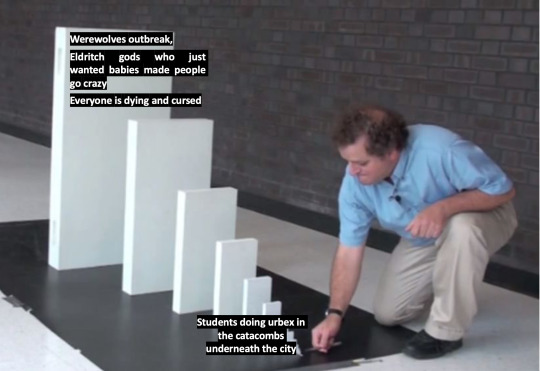
Seriously I needed to know what happened!!!
So little by little I imagined a really big story. And I figured it could be interesting to try to share it. And not just explain or do it in form of headcanon but maybe write about it!
At first I try to fill the gasp with fanfictions, I read a lot but there wasn't much about the squad back at Byrgenwerth (with the meeting of Wilem, Gehrman, Laurence, Dores & the Gatekeeper, Patches, Maria, Caryll, Micolash, Rom, Damian etc and their crazy university adventures XD) so I figured I just had to do it myself. And tada
There isn't a lot of fic retracing the entire lore, chronology & backstory so I actually made a big plan for my story that is supposed to be at least in 4 separate multi chapter fanfics.
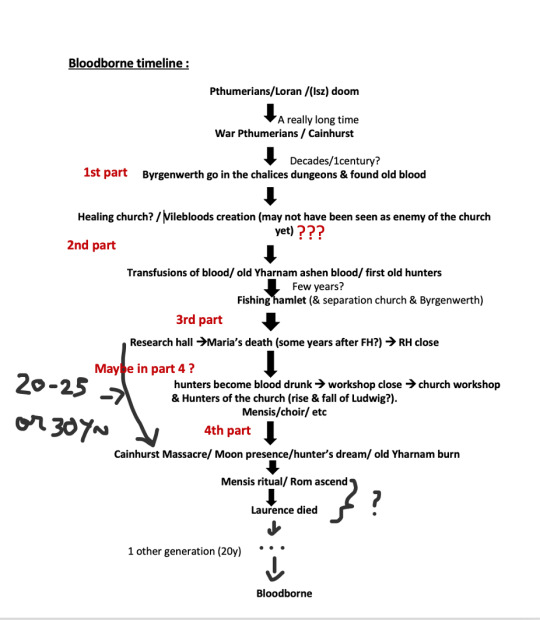
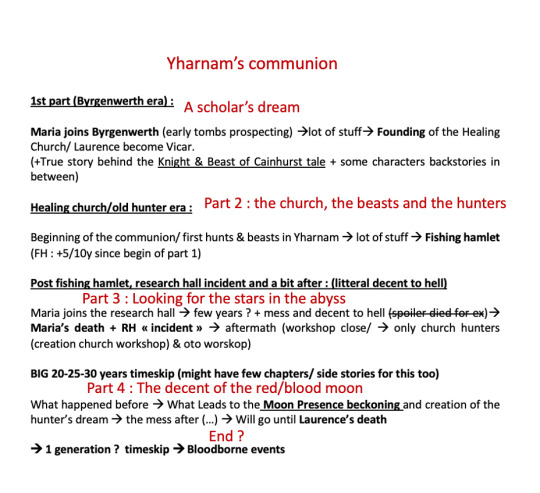
It's a really simple plan here but I have a more detailed draft & plan on a document.
But I'm not a great and fast writer so if I can at least finish the first one ( a scholar's dream) I would be really happy :)
If there is a Part5 it would be about Henryk, Djura, & Gascoigne and everyone who arrived before the hunter but because my brain is not hyperfine on those characters I don't have lot of idea so no I don't wanna write on it for now XD
#part 1 : a scholar's dream#bloodborne fanfiction#bloodborne#my fanfiction#my asks#that remind me I need to finish writing chapter 6 ahhhh
10 notes
·
View notes
Text
Physics "Friday" #11 [Opinion]: Okay so I have a few more problems with SI Units
Preamble: Now what Missy?
Education Level: Primary School (Y5/6)
Topic: Measuring Systems (Metrology)
Ok so this was going to be my necessary follow up to my first opinion post, Is Fahrenheit the better temperature scale?
I was meant to save it for the next time I had too much stuff to deal with on Friday and needed to write something easier. In fact, that's going to be how I do opinion posts - when I don't need to do as much a-thunkin'.
Regardless, there are of course other problems with the SI units system that many people point out. This is basically me doing it myself.
What are the SI Units?
During the french revolution, there were several attempts to metricise the existing unit system. Generating standardised units on length, volume, weight, temperature ... they even tried to decimalise time.
These units were based off physical constants:
The metre was one 10 millionth the distance from the north pole to the equator
The litre was the volume taken up by one kilogram of water
Celsius was based on the boiling/melting points of water
A kilogram was based on the weight of a specific Platinum-Iridium Alloy called the IPK (International Prototype Kilogram)
Now obviously, these weren't perfect constants. The earth's radius changed, the boiling point of water depends on the pressure of the environment, and the IPK can vary based on surrounding conditions.
This was fixed in 2019, when every SI measurement unit was defined using a universal constant rather than physical objects like a mass or the earth:
Hyperfine transition frequency of Caesium
Speed of light
Planck Constant
Charge of the Electron
Boltzmann Constant
Avogadro's Constant
Luminous Efficacy of 540 THz radiation
This gives our seven SI units:
Time (Second)
Distance (Meter)
Mass (Kilogram)
Charge (Columb)
Temperature (Kelvin)
Amount (Mole)
Luminous Intensity (Candela)
Problem #1: Unit-less units
There are several units that come from mathematics that appear to be unitless, like:
Angle (Radians)
Solid Angle (Steradians)
Amount (Number count)
We use this all the time like in lumens (candela steradians), angular velocity (radians per second), and number density (particles per cubic metre).
Wait ... amount was already listed as an SI quanity - it was a mole wasn't it?
That's exactly it. A mole is just defined as 6.022×10²³ objects of something. This is where we experience our first problem.
Why is radian and steradian not considered a unit in it's own right but a mole is?
Radians are defined as being one metre per metre. The angle required to create an arc with a length of 1 metre given a radius of one metre.

Image Credit: BYJU's
This comes from the formula S=Rθ where circular arc length (S) is equal to the radius (R) multiplied by angle in radians (θ).
The problem with this, is that the radian is still an arbitrary dimension. We could've chosen our standard angle unit to be a degree, and all we need to do is change the definition of the sine function and the above arc length definition:
S=kθR were kθ is dimensionless and k = 1 rad⁻¹
It's almost as if, while the radian is dimensionless, it still behaves and acts like a unit. Much like how we can redefine everything and make the unit for length be a foot instead, we can do the same with angle.
You may object, as S=Rθ looks a lot more fundamental than adding an extra unneeded constant. But it's like if we were to use natural units, where the speed of light is equal to 1, making E = mc² actually E = m.
This doesn't mean that m is somehow 'fundamental' when we define it in terms of energy. All we've done is redefine our unit system in a way that makes a few constants equal to one.
The same thing goes for radians.
A little side-note on Intensity
You could argue that this also applies to relative intensity units like Magnitude or Bels. However, I'd argue that they don't count as their unit systems are defined as being relative. The strength of a signal or luminosity is just choosing a unit system of power.
For example, relative magnitude is based on the luminosity of the sun. Sound/Signal amplitude is based on watts or volts.
Problem #2: Redundant Units
Many of the quantities in the SI unit system are technically redundant. Temperature can just be redefined as energy density, mass can be redefined as energy, etc.
What I'm concerned with is one unit in particular: the Candela - what exactly is it?
I often find that a lot of people attempting to explain the SI unit system often brush over this unit, even though it feels rather important given it's called 'Luminous Intensity'.
But hold on, isn't luminosity just about energy production? After all, radiation is just energy, and it's emitted as a form of energy.
A candela is equal to one lumen per steradian, where a lumen is the total luminous intensity of an object that emits light everywhere. Candelas concern luminous intensity from a specific solid angle view of the object.
Watts, the measurement of power and bolometric luminosity, measure the total (or bolometric) luminosity of an object at all wavelengths of light.
Lumens, on the other hand, represent the power produced by an object after each wavelength is passed through some filtering function that accounts for how the human eye sees light. This weighting function is determined by the ISO.
Of course, our eyes only see light within a particular range, and inside of that range, different wavelengths appear more intense to us because we pick it up more.
But this fails to recognise that this is still just a glorified unit of power. Just because it's weighted based on some function, shouldn't change what unit is necessarily uses. Hence it is technically redundant as it can be defined as a combination of other SI units - similar to radians.
Problem #3: When the unit system isn't used
I mentioned it in the last post, but there are a lot of occasions where the standard SI units aren't used. The worst culprit I feel is Astronomy, with Physics only having issues in lieu of SI vs. Natural units vs. Electron/Atomic Units. Again here's the list:
My beloved SI units
CGS Units
Whatever the fuck a Jansky is
Don't even start with natural units I can't live without big G
"Ampere in CGS units is g1/2 cm3/2 s−2"
Solar Luminosity/Mass of Sun
Angstroms (like please can we just use nanometers?)
How many Jupiters or Earths fit into this cloud of gas?
The vomit of parallax units i.e. AU, pc, Mpc, arcseconds, radians
Steradians (Solid angles can be finicky)
Logarithms, logarithms everywhere!
Hubble's constant being in km/s/Mpc but then having to turn that into Hz or per year - like can someone please acknowledged how cursed this is?
When you do Kepler's 3rd law on Mercury and realise it doesn't work (because you forgot Einstein existed) ... so no units end up working
ADUs and/or whatever you get when you deal with telescope outputs
Sidereal time, J2000, etc.
Sky Coordinates (it always depends on the telescope mount)
(the last two are new entries into the list I forgot!)
A lot of these units are very, very, annoying to handle. Often at times because they are just so unnecessary. We have scientific notation for a reason - so why are we using Jansky? Why ever use the mass of planets unless if we are talking about specifically exoplanets?
It can especially be annoying when in astronomy course subjects, unit conversions make up like 50% of the work and 50% of the error in calculations.
And the biggest problem, of course, is the CGS units system. I hate it. So much. From what I know CGS is used simply because it appears as more correctly "scaled" for a lot of astronomical processes.
However, the problem is that it just adds extra conversion factors into every equation. Now I have to remember big G in both CGS units as well as in SI or solar units etc. And it doesn't jive with a lot of other astronomical units.
J2000 is also rather annoying - why are we using the Julian calendar at all? Shouldn't we try and strive for using a more accurate year instead? Because what happens is that every four years the calendar shifts by a day.
The "Ampere in CGS units is g1/2 cm3/2 s-2" is a direct quote from one of my professors. And it also makes very little sense - because it says that the coulomb and ampere units are actually redundant.
However, CGS units aren't usually the only thing we use. Sometimes we put things in Gaussian CGS units, where we define the coulomb's constant (kₑ) as being 1. Thus, similar to natural units, we can define a statCoulomb in terms of our three base units:
1 statC = 1 g1/2⋅cm3/2⋅s−1.
Now this is where we find our ampere definition! But wait ... this is materially different to the real ampere. In fact, we can determine the difference between coulombs and statcoulombs:
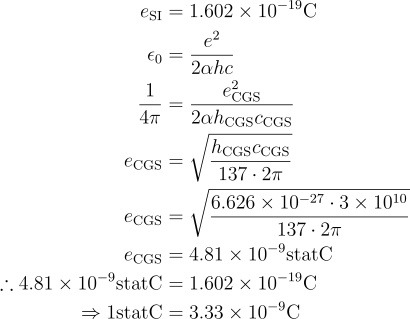
So they are different! And thus, after several paragraphs, my lecturer is wrong and they shouldn't've used the Ampere but a different stat ampere.
So what would I do?
Well, the big problem with all unit systems is that they are just equivalent to eachother dimensionally.
Because of all the seperate equations surrounding each of the SI units, we can define any SI unit in terms of any other SI unit combination just by setting certain constants to one.
So there's quite a lot of units that we could me missing.
But here's how I would do it ...
There are five unique SI units:
Distance - Metre
Time - Second
Mass - Kilogram
Charge - Coulomb
Temperature - Kelvin
There are also three dimensionless/special units:
Amount - Mole
Angle - Radian
Luminosity - Lumen
These three units are special as they can be expressed as dimensionless constants or in terms of other units, however we want them to be expressed in our own specific units.
Solid Angle is just determined from square radians where 1 sr = π/4 rad² (ratio of square and circle of same diameter).
The constants which define these unique units are:
Hyperfine transition frequency of Caesium
Speed of light
Planck Constant
Charge of the Electron
Boltzmann Constant
For the non-unique units we have:
Avogadro's Constant
Pi
Luminous Efficacy of 540 THz radiation
Conclusion
This post did end up taking longer than I expected ... much longer. Nevertheless it was fun to do!
As stated in the start, opinion posts are for those Fridays where things aren't as easy as spending 2-3 hrs writing a post. Because when you want to argue a point you have a little more passion behind it.
Anywho. Did you know that only 5% of people who read this post actually follow this channel?. SMASH THAT FUCKING LIKE AND SUBSCRIBE. Brought to you by Raid Skillspace VPN™.
Feedback's always welcome. Come and debate me you cowards. Follow if you like it ... or don't.
#physics friday#stem#academics#stemblr#science#astronomy#si units#Finding hashtags for metrology is a bit difficult
10 notes
·
View notes
Text
went to a gflip concert last minute the other night and i can't stop listening. my brain is just hyperfine rough about you real life morning the worst person alive on loop
1 note
·
View note
Text
this chart really overcomplicates things, if you can do simple division then you're okay. 48 teaspoons in a cup, 16 tablespoons in a cup, 2 cups in a pint, 2 pints in a quart, 4 quarts in a gallon, all the rest is just standard division that you should know. yeah, they're not necessarily intuitive conversions but the definition of meter is just one 299792458th the distance light travels in a second, and a second is defined by "taking the fixed numerical value of the caesium frequency, ΔνCs, the unperturbed ground-state hyperfine transition frequency of the caesium 133 atom, to be 9,192,631,770 when expressed in the unit Hz, which is equal to s−1; so it's not necessarily weird compared to other measurement systems

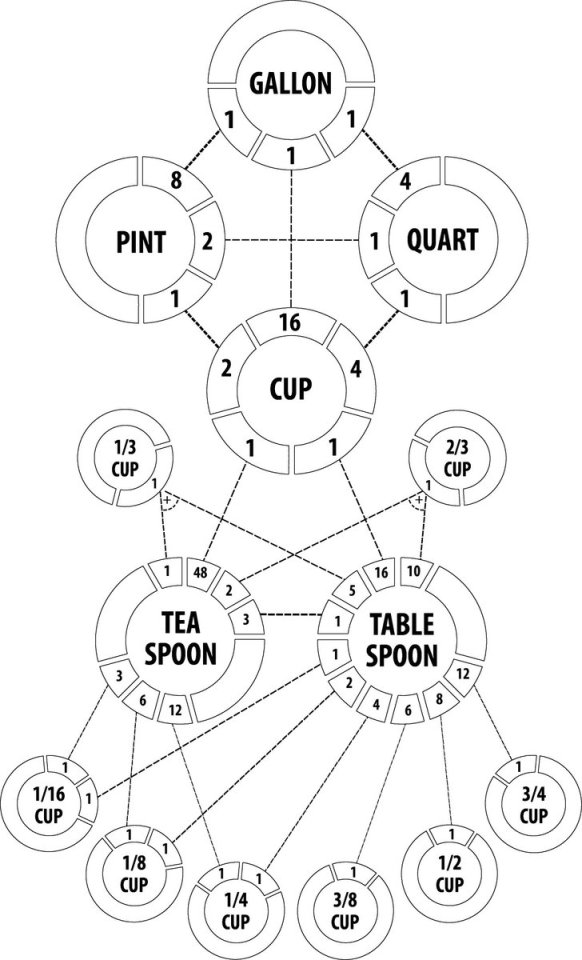
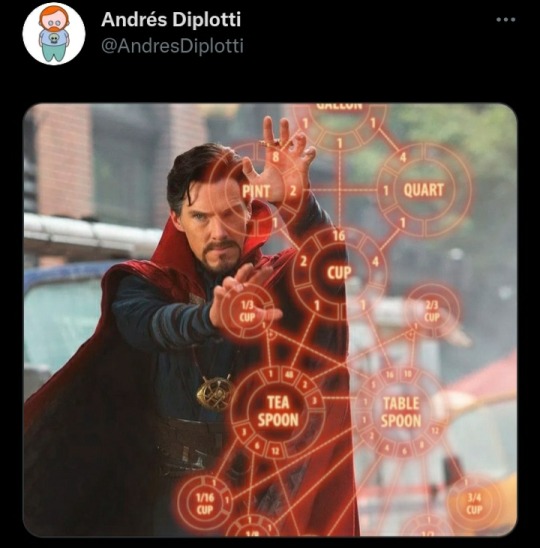
246K notes
·
View notes
Text
Nuclear Spin Quantum Control In Alkaline-Earth Atoms
Nuclear Spin Quantum
The nuclear spin of alkaline-earth atoms, particularly strontium-87 (({}^{87}\text{Sr})), presents ample potential for developing quantum technologies like sensitive metrology and quantum computing. Nuclear spin of a single ({}^{87}\text{Sr}) atom, with F=9/2 spin quantum number, has 10 spin states, unlike ordinary qubits with only two states (0 and 1). Due to its multi-state capabilities, it can operate as a “qudit,” considerably increasing the quantum information that can be encoded in a single atom.
Nuclear spin’s strong isolation from outside perturbations makes it ideal for quantum information. Due to its nuclear composition, low vector and tensor polarisabilities in the ground state, and small Landé factor, the atom is immune to stray magnetic field gradients and spin-dependent light shifts. This intrinsic robustness allows coherent superpositions to last for many seconds, resulting in extremely extended coherence times, according to researchers. We achieved a 40 ± 7 second echo coherence time (({T}{2}^{{{{\mathrm{echo}}}}})) and an estimated 21 ± 7 second Ramsey dephasing time (({T}{2}^{\star })).
High-Dimensional Coherent Control
These high-dimensional nuclear spin states require manipulation beyond spin precession (using su(2) generators) to properly utilise their quantum potential. Scientists used a complicated tensor light shift approach to do this.
The TLS generates a quadratic energy shift between Zeeman states proportional to (m_F^2) using a calibrated laser beam. Scientists can manipulate two-photon Raman resonance settings with this energy change. Careful detuning lets them coherently manage isolated spin states. Engineering unitary transformations from su(N) generators allow for more flexible spin precession control than ordinary spin precession. Experiments for coherent operations have shown high fidelity, often greater than 99% for certain states.
Two main types of Raman transitions have been identified:
(\boldsymbol{\delta}\text{mF}=\mathbf{1}) Spin-changing transitions: These transitions between neighbouring Zeeman sublevels (e.g., m_F = -5/2) and m_F = -3/2) are achieved by absorbing (\pi)-photons from the TLS beam and (\sigma^-) photons from the Raman beam. These exhibit high fidelity (0.994) for a (\pi/2) pulse.
The formula is (\boldsymbol{\delta}\text{mF}=\mathbf{2}). Modulating the Raman laser into two frequency components causes spin-changing transitions that modify nearby Zeeman sublevels (e.g., m_F = -7/2) and -3/2). While these two-level rotations are similar, they have more severe damping (fidelity ~0.90 for a (\pi/2) pulse) in recent investigations.
The experimental setup for these operations is:
Optical Tweezers: SLMs build holographic arrays that trap individual ({}^{87}\text{Sr}) atoms. “Phoenix” from Atom Computing, Inc. uses such a platform.
Two phase-coherent laser beams, the Raman beam for transitions and the TLS beam for quadratic energy shift, are created from a single source and carefully regulated using acousto-optic modulators (AOMs) and electro-optic modulators (EOMs).
Spin State Measurement: Spin-selective momentum transfer measures spin-state distribution after an experiment cycle.
Interferometry and Applications of Qudit
These high-dimensional nuclear spin states can be coherently manipulated, enabling quantum simulation and sensing.
Ramsey interferometry describes qubit coherence. Inhomogeneity and polarisation changes in the TLS beam can cause decoherence and phase noise, but turning it off adiabatically during the interferometer’s dark period reduces these effects. Long-lived coherent superpositions over seconds are observed.
Parallel Ramsey Interferometers for Multi-Parameter Sensing: This innovative method observes many external fields on atoms simultaneously. Use independent pairings of spin states in the atom’s hyperfine structure to operate two Ramsey interferometers simultaneously to detect characteristics like quadratic and linear Zeeman shifts. Parallelisation allows correlation analysis of numerous noise sources and common noise rejection, which sequential observations cannot do.
The simultaneous measurement of many non-commuting observables is generally forbidden by quantum mechanics. This solution solves the problem. During measurement, the approach coherently translates information from main qubit states into initially empty “ancillary” spin states, extending the atoms’ Hilbert space. Controlled rotations on the qubit and auxiliary states can reveal previously unobservable non-commuting observables in the extended state space’s final population measurement. This technique allows new physics investigations and better collective atomic state characterisation.
Future outlook and directions
These findings are promising, but more research is needed to optimise these systems. Cross-talk between nearby qubits, Stark-shift beam dispersion, and quasi-degeneracy prevent simultaneous control of all 10 spin states. Future efforts aim to reduce these by:
Applying stronger magnetic fields.
Using advanced pulse shaping to reduce non-resonant population transfers.
Narrower optical transitions, like the ({}^{1}\text{S}_0 \to {}^{3}\text{P}_2) transition, are being studied for TLS engineering to reduce spontaneous emission.
The goal is to increase computational array sizes and achieve quicker gate operation durations, with system coherence times 10(^8) times longer than gate lengths.
High-dimensional nuclear spins in alkaline-earth atoms like strontium-87 require these advancements for next-generation quantum sensors and universal quantum computers. Large nuclear spins with su(N) symmetry are intriguing for quantum many-body physics and offer new opportunities to study quantum magnetism.
#NuclearSpinQuantum#quantumcomputing#Nuclearspin#tensorlightshift#quantumsimulation#quantummechanics#qubits#News#Technews#Technology#TechnologyNews#Technologytrends#Govindhtech
0 notes
Text
Week 12_Final Outputs_Final Poster Edits
Editing:
When I edited my photos for my posters, I wanted even, neutral lighting with slightly intensified highlights on the face, inspired by editorial lighting. This meant they could easily be edited in tones and brightness, etc, in Photoshop later without losing much detail.




I added of grain and dust to backdrop to give a vintage feel but not the image to keep them crips and honour the focus within them. I felt this added a slight ode to the time period without being overly aged. I also added a radial gradient to give the appearance of weathered edges and bring intention to the image in the middle of the poster. For the type, I used Futura and script typeface to give a vintage feel in a deep red to keep it hyperfine but not overly bright.
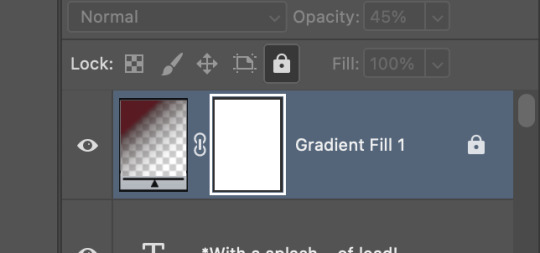

Final image selection - swapping the femme fatale image
Rationale: I felt the second image felt more objectifying, versus the first felt too powerful (horrifying to say as a woman). The lipstick on the lips is also more pronounced in the second. Therefore, it feels more like a lipstick ad. The movement of the second also gives a sexy feel as well as wraps around the posters nicely, creating eye movement.


I was also conflicted on the colour treatment of the product shot, so I tested both gold in tone and more neutral. Initially, I liked the neutral, but in the end, I felt the gold was stronger as it points your eye to it, and the contrast is quite pleasing.


Minor enhancements of the images were done with a bit of generative AI to fill in hair and remove a patch of white on a button. Alongside an enhancement of a tear drop with a pink overlay, and turning the tape measure pink through masking.
0 notes
Text
I know you guys are joking but actually we do in fact have physical representations of several units in science.
For instance, we have the original object that was used to define the Kilogram:
And, fun fact, the second is precisely defined as "the unperturbed ground-state hyperfine transition frequency of the caesium 133 atom". (Wikipeda) Basically, we define the second based on the frequency of radiation that comes off cesium.
We also define the meter using the same kind of observation, and it is defined as the length of a beam of light in a vacuum after it has traveled 1/299,792,458 of a second.
it’s a common misconception that maths is all theoretical; they actually keep the 0 in a vault in France and u can go look at it if u got connections.
15K notes
·
View notes
Text

Time in SI Units
Time is defined as the sequence of events and existence in an apparently irreversible march forward, often referred to as the fourth dimension. It is one of the seven fundamental physical quantities as defined in the SI unit system, with the base unit of time as the second used to measure intervals of time. The second has been around for centuries, first appearing on mechanical clocks in Europe in the late Middle Ages, and has had three standard definitions during that time:
As a fraction of a day (by the 1940s to be 1/86,400 of a solar day)
As a fraction of a year ("the fraction 1/31,556,925.9747 of the tropical year for 1900 January 0 at 12 hours ephemeris time" as of 1956)
And the modern definition as of 1967 as defined as the frequency of microwave radiation from cesium atoms ("the duration of 9,192,631,770 periods of the radiation corresponding to the transition between the two hyperfine levels of the ground state of the caesium-133 atom")
The second is the only SI unit of time, but while prefixes are common for intervals smaller than a second (millisecond, picosecond, etc.), it is rare for prefixes to be used for units larger than a second (megasecond, terasecond). Instead, the historic units of minutes, hours, days, months, years, etc., none of which are SI units, are typically used.
Sources/Further Reading: (Image source - Time Wikipedia) (Second Wikipedia) (NPL) (PTB) (Time NIST) (Second NIST)
15 notes
·
View notes